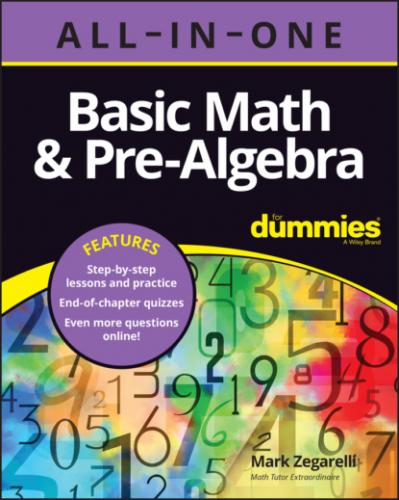And here’s an example of how division is non-commutative:
For example, when you have five dog biscuits to divide between two dogs, each dog gets two biscuits and you have one biscuit left over. But when you switch the numbers and try to divide two biscuits among five dogs, you don’t have enough biscuits to go around, so each dog gets none and you have two left over.
Through the commutative property and inverse operations, every equation has four alternative forms that contain the same information expressed in slightly different ways. For example, and
are alternative forms of the same equation but tweaked using the commutative property. And
is the inverse of
. Finally,
is the inverse of
.
You can use alternative forms of equations to solve fill-in-the-blank problems. As long as you know two numbers in an equation, you can always find the remaining number. Just figure out a way to get the blank to the other side of the equals sign.
When the first number is missing in any problem, use the inverse to turn the problem around:
When the second number is missing in an addition or multiplication problem, use the commutative property and then the inverse:
When the second number is missing in a subtraction or division problem, just switch around the two values that are next to the equals sign (that is, the blank and the equals sign):
Q. What’s the inverse equation to
A. . In the equation
, you start at 16 and subtract 9, which brings you to 7. The inverse equation undoes this process, so you start at 7 and add 9, which brings you back to 16:
Q. What’s the inverse equation to
A. In the equation
, you start at 6 and multiply by 7, which brings you to 42. The inverse equation undoes this process, so you start at 42 and divide by 7, which brings you back to 6:
Q. Use inverse operations and the commutative property to find three alternative forms of the equation .
A. First, use inverse operations to change subtraction to addition:
Now use the commutative property to change the order of this addition:
Finally, use inverse operations to change addition to subtraction:
Q. Fill in the blank: .
A. 39. Use inverse operations to turn the problem from division to multiplication:
Now you can solve the problem by multiplying
Q. Solve this problem by filling in the blank:
A. 31. First, use the commutative property to reverse the addition:
Now use inverse operations to change the problem from addition to subtraction:
At this point, you can solve the problem by subtracting .
Q. Fill in the blank: .
A. 49. Switch around the last two numbers in the problem:
Now you can solve the problem by subtracting
1 Using inverse operations, write down an alternative form of each equation:
(a)
(b)
(c)
(d)
2 Use the commutative property to write down an alternative form of each equation:
(a)
(b)
